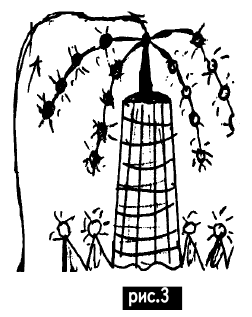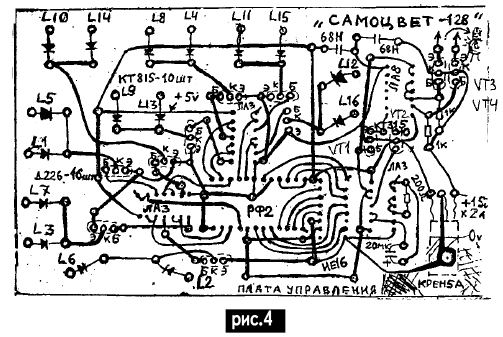Light and music installation Samotsvet-128. Encyclopedia of radio electronics and electrical engineering

Encyclopedia of radio electronics and electrical engineering / Color and music installations, garlands
 Comments on the article
Comments on the article
"Gem 128" (Fig. 1) has 128 different illumination programs, each of 128 is repeated twice.

(click to enlarge)
The total cycle time is about 5 minutes. After this time, the programs are repeated from the beginning. The number of garlands is 4. They are made of standard incandescent lamps (13,5 V x 0,15 A). The connection diagram of the garlands is shown in Fig. 2.

All four garlands are connected to the block via tape recorder 5-pin connectors. The use of such connectors is very convenient: all garlands are connected separately and do not get confused during storage. They can be hung on a Christmas tree with beams converging at the top (Fig. 3).

The connection scheme of 16 lamps in four garlands allows the inclusion of one, two and simultaneously all lamps in various combinations in dynamic mode. This mode ensures the simultaneous flow of current through no more than 8 lamps, so the total current consumption for all 16 lamps is not more than 1,2 A. Alternate, fast for the eyes, imperceptible switching "draws" 128 different dynamic figures. It is impossible to list their combinations, it is better to see once!
To eliminate parasitic illumination in the garlands, 16 diodes of the D226 type were used, which are mounted vertically on the printed circuit board (Fig. 4). The "dynamics" of the garlands is provided by two transistors (VT3, VT4), controlled by open-collector inverters, and this is the K155LA8 microcircuit, in which two elements remain free.

Please note that an unstabilized voltage of 3 V is supplied to the collectors VT4, VT15. The rectifier should provide a current of up to 2 A. The author used TVK110 with Uout \u12d 1 V and I out \u202d 142 A as a power transformer. It turned out to be quite enough. The rectifier diodes (KD5 type) are located on the radiators in the same way as the KR5EN16A integral stabilizer with an output voltage of 307 V, which supplies the unit's microcircuits and a control display made up of XNUMX ALXNUMX multi-colored LEDs.
The LED matrix circuit board is shown in Figure 5.

The installation step is 10 mm, the LEDs are connected directly to each other by leads. Panel thickness for LEDs 5...7 mm. This will protect the device from overheating. Be careful when soldering LEDs. Do not "swing" them until the soldered conclusions have completely cooled down!
The control display and garlands repeat the program written to ROM DD4: the active level for D0-D7 is low. The addresses of the memory cells are "selected" by the counter DD2 (K561IE16) at a rate of 8 bytes / s, and the switching of "dynamic" keys at a frequency of 64 Hz. It is at this frequency that the clock generator, implemented on two DD1 elements of the K155LA3 type, operates.
A few words about the pinout of the AL307 LEDs (Fig. 6). For "red" the anode terminal is wider than the cathode, while for "green" and "yellow" - the opposite is true.

"Gem-128" for disco
The schematic diagram is shown in Fig.7.

(click to enlarge)
For the correct operation of the program, the AO input of one MS memory is grounded, and the other one is connected to +5 V. The keys use 16 KT315B transistors and 16 KU202N thyristors. Between the outputs of the ROM and thyristors (instead of KT315) it is more convenient to put inverters of the K1555LN1 type (3 pcs.).
Author: A. P. Simutin
 See other articles Section Color and music installations, garlands.
See other articles Section Color and music installations, garlands.
 Read and write useful comments on this article.
Read and write useful comments on this article.
<< Back
 Latest news of science and technology, new electronics:
Latest news of science and technology, new electronics:
Energy from space for Starship
08.05.2024
Producing solar energy in space is becoming more feasible with the advent of new technologies and the development of space programs. The head of the startup Virtus Solis shared his vision of using SpaceX's Starship to create orbital power plants capable of powering the Earth. Startup Virtus Solis has unveiled an ambitious project to create orbital power plants using SpaceX's Starship. This idea could significantly change the field of solar energy production, making it more accessible and cheaper. The core of the startup's plan is to reduce the cost of launching satellites into space using Starship. This technological breakthrough is expected to make solar energy production in space more competitive with traditional energy sources. Virtual Solis plans to build large photovoltaic panels in orbit, using Starship to deliver the necessary equipment. However, one of the key challenges ... >>
New method for creating powerful batteries
08.05.2024
With the development of technology and the expanding use of electronics, the issue of creating efficient and safe energy sources is becoming increasingly urgent. Researchers at the University of Queensland have unveiled a new approach to creating high-power zinc-based batteries that could change the landscape of the energy industry. One of the main problems with traditional water-based rechargeable batteries was their low voltage, which limited their use in modern devices. But thanks to a new method developed by scientists, this drawback has been successfully overcome. As part of their research, scientists turned to a special organic compound - catechol. It turned out to be an important component that can improve battery stability and increase its efficiency. This approach has led to a significant increase in the voltage of zinc-ion batteries, making them more competitive. According to scientists, such batteries have several advantages. They have b ... >>
Alcohol content of warm beer
07.05.2024
Beer, as one of the most common alcoholic drinks, has its own unique taste, which can change depending on the temperature of consumption. A new study by an international team of scientists has found that beer temperature has a significant impact on the perception of alcoholic taste. The study, led by materials scientist Lei Jiang, found that at different temperatures, ethanol and water molecules form different types of clusters, which affects the perception of alcoholic taste. At low temperatures, more pyramid-like clusters form, which reduces the pungency of the "ethanol" taste and makes the drink taste less alcoholic. On the contrary, as the temperature increases, the clusters become more chain-like, resulting in a more pronounced alcoholic taste. This explains why the taste of some alcoholic drinks, such as baijiu, can change depending on temperature. The data obtained opens up new prospects for beverage manufacturers, ... >>
 Random news from the Archive Random news from the Archive Cabbage harvested in space
23.02.2017
The ISS crew harvested the first Chinese cabbage crop in orbit.
The harvest of six small bushes of cabbage with a few leaves each was carried out by flight engineer Peggy Whitson, who, upon arrival at the station, among other things, followed the "garden". According to NASA, the crew will be given a taste of the plant, but most of the harvest will be sent to Earth for study.
Seeds of Chinese cabbage Beck Tokyo (Tokyo Bekana) arrived on the ISS in April last year. Initially, one of the six seeds did not germinate, probably due to the fact that do not get enough moisture, but as the project leaders said Whitson achieved that and it has risen.
The project for growing vegetables in weightlessness is intended to diversify the diet of the crew in the future and prepare for the longer and more autonomous missions, including missions to Mars. As noted in the NASA, this is the fifth harvest of various vegetables in orbit. In the selection of crops to be sent to the ISS by NASA is guided, first of all, the ability to use locally grown vegetables in their raw form, as well as their nutritional properties.
A year ago, NASA astronaut Scott Kelly said that on board the ISS for the first time blossomed flower asters, zinnias.
|
 Other interesting news:
Other interesting news:
▪ The phone monitors the child
▪ There are deposits of ice at the poles of the moon
▪ The MP3 format is officially free
▪ DRE120 and DRE240 are compact, efficient DIN rail power supplies
▪ Dual GPU Nvidia Tesla K80
 News feed of science and technology, new electronics
News feed of science and technology, new electronics
 Interesting materials of the Free Technical Library:
Interesting materials of the Free Technical Library:
▪ website section LEDs. Article selection
▪ article Nervous diseases. Crib
▪ article Who published a book that encrypted itself after the first reading? Detailed answer
▪ article Soldering and tinning products. Standard instruction on labor protection
▪ entry-level Lamp UMZCH article (bug fixes). Encyclopedia of radio electronics and electrical engineering
▪ article Electric octopus. physical experiment
 Leave your comment on this article:
Leave your comment on this article:
 All languages of this page
All languages of this page
Home page | Library | Articles | Website map | Site Reviews

www.diagram.com.ua
2000-2024







 Arabic
Arabic Bengali
Bengali Chinese
Chinese English
English French
French German
German Hebrew
Hebrew Hindi
Hindi Italian
Italian Japanese
Japanese Korean
Korean Malay
Malay Polish
Polish Portuguese
Portuguese Spanish
Spanish Turkish
Turkish Ukrainian
Ukrainian Vietnamese
Vietnamese







 Leave your comment on this article:
Leave your comment on this article: